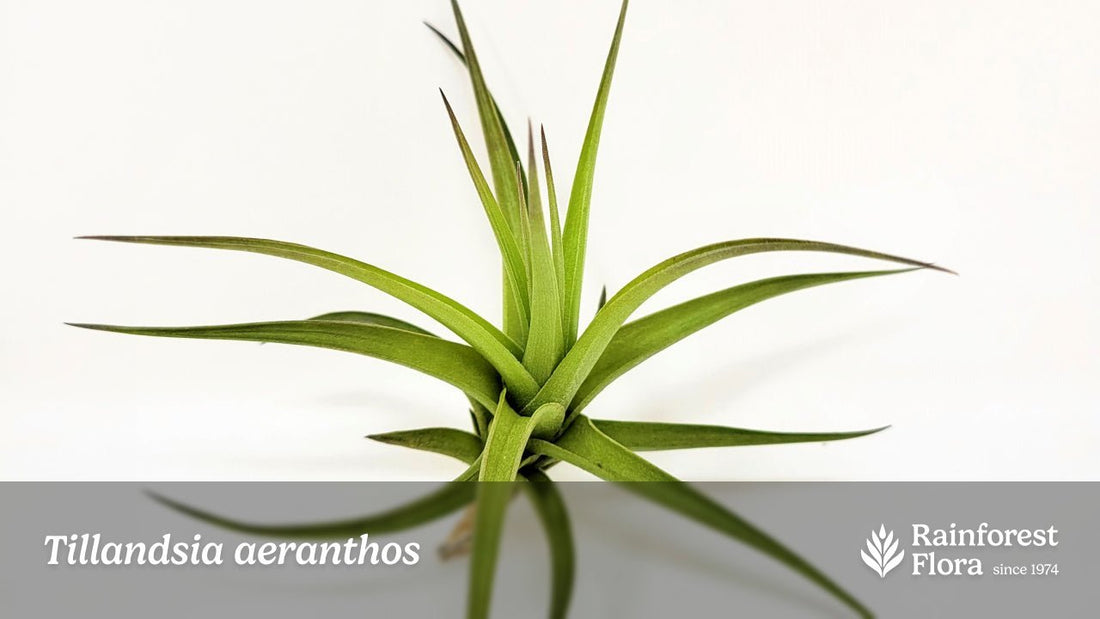
Notes from Tillandsia II: Tillandsia aeranthos
Share
When our co-founder, Paul Isley, wrote Tillandsia II, his guide to Tillandsia species, cultivars, and hybrids, we never imagined its impact. Thousands of plant lovers have told us how this book shaped their horticultural journey.
To celebrate its legacy, we'll share excerpts here, one plant at a time. If you're new to Tillandsia, we hope it sparks a lifelong love. –the Rainforest Flora Team
Tillandsia aeranthos
L.B. Smith; 1943
(eye-RAHN-thos)
Subgenus: Anoplophytum
Aeranthos is a latinized combination of the two Greek nouns, aer and anthos, which mean "air" and "flower" respectively. Therefore, aeranthos means "air blooming." The botanist Loiseleur described this species as Pourretia aeranthos in 1821. In 1943, it was included in Tillandsia.
Tillandsia aeranthos grows epiphytically from near sea level to several hundred meters in Argentina, Uruguay, Brazil, and Paraguay. It has a preference for mature tipa trees (Tipuana tipu) and tends to grow singly or in small clusters of two to a dozen plants.
A caulescent (growing along a stem) species, Tillandsia aeranthos has an average dimension of 11-13 centimeters in diameter and height. The leaves are spreading to erect, densely polystichous (leaves emanating in all directions from the stem), and covered with appressed (lying flat, parallel to epidermis), cinereous (ash-colored) trichomes. The leaf blades are narrowly triangular and attenuate (long, tapering to a point).
This species is virtually indistinguishable from Tillandsia bergeri in the non-blooming state. Both T. aeranthos and T. bergeri can be used to indicate the state of species hydration or dehydration (desiccation) in one's collection. The succulent leaf blades are only slightly channeled when hydrated, but they are deeply involute (leaf edges curled up) and narrower when dehydrated.
The slender scape exserts the simple (single) bloom spike beyond the leaves. The floral bracts are ovate (egg-shaped and attached at the widest end) and ruby red. The flared petals of the polystichous flowers are often an indigo so deep as to appear almost black. Tillandsia aeranthos blooms annually, and the entire flowering cycle lasts close to a month. It produces roots quickly when well cultivated and readily attaches itself to the mounting substrate.
The colorful bloom of Tillandsia aeranthos, as well as those of other species, has won admiration among the Argentines who refer to them as claveles del aire, or "carnations of the sky." In addition, T. aeranthos is probably the only species to be immortalized in song. The tango Clavel del Aire was scored and lyricized by Juan de Dios Filiberto and F. Silva Valdez in 1935.¹
This species does not develop as many offsets over its life cycle as does Tillandsia bergeri. However, it usually produces three to six after blooming, and after a few years in cultivation, it, too, develops into a large clump.
- "El Inolvidable Filiberto"; Copyright 1934/35, EMI-ODEON SAIC (Argentina).


1 comment
Yes, my mother sang that song. Filiberto, and of course the Carlos Gardel noir tangos. My T. aeranthos is now as big as a football (not as big as a futbol yet) and is putting out three flower shoots, slowly, since late June in southern California, and I am a rapt audience of this clavel del aire.